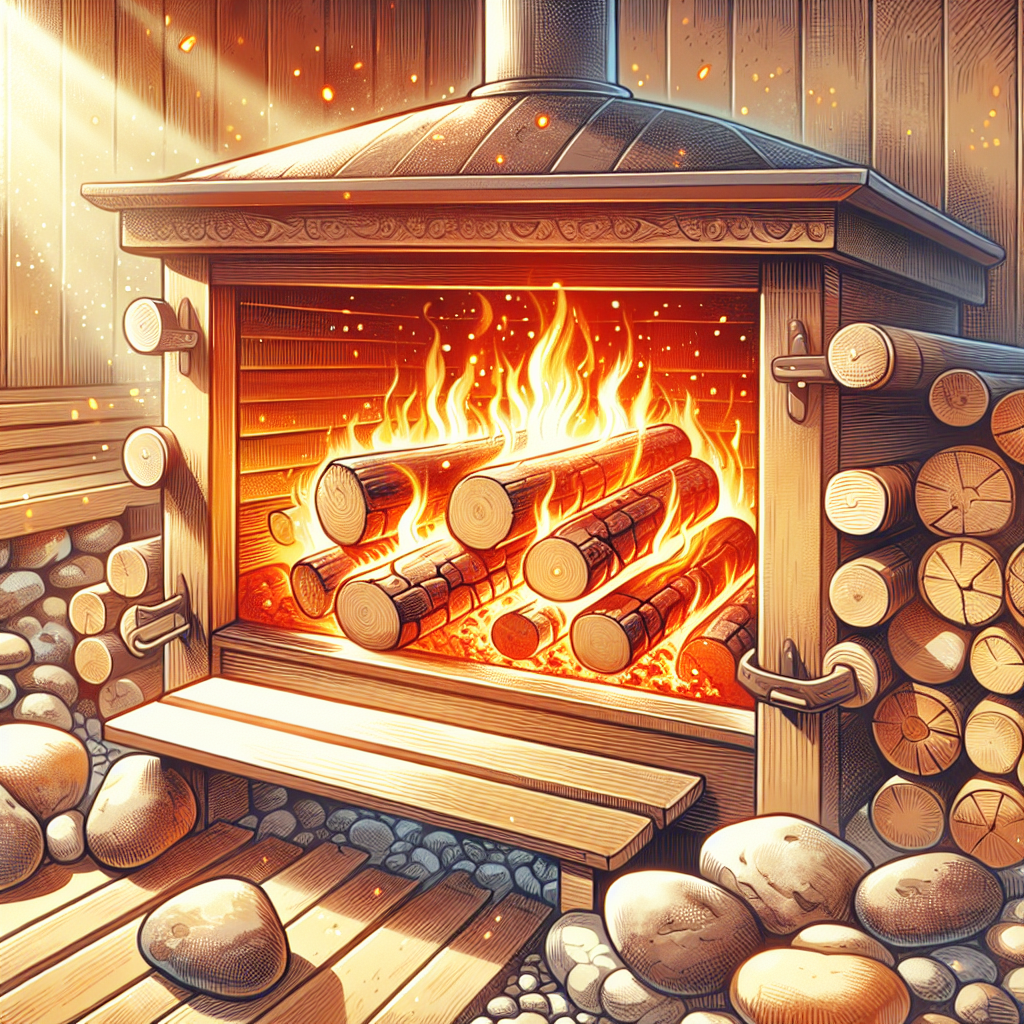Are you someone who enjoys the soothing and therapeutic benefits of a traditional sauna? If so, you may have wondered about the optimal way to heat up this ancient relaxation space. In this article, we will explore the best practices for properly heating a traditional sauna, ensuring that you get the most out of your sauna experience. From setting the ideal temperature to adding the perfect amount of water to create steam, we will guide you through the steps to achieve the perfect sauna session that will leave you feeling rejuvenated and refreshed. So sit back, relax, and let’s dive into the world of traditional sauna heating!
Choosing the Right Type of Sauna
When it comes to choosing the right type of sauna for your needs, there are a few options to consider. Two popular choices are wood burning saunas and electric saunas.
Wood burning saunas provide a traditional and authentic sauna experience. The heat is generated by burning wood in a dedicated stove or heater, which creates a unique and aromatic atmosphere. This type of sauna is often favored by those who appreciate the natural and rustic ambiance it provides.
On the other hand, electric saunas are powered by electricity and offer a more convenient and easily controllable heating experience. Electric saunas are typically equipped with heating elements that efficiently heat the sauna room, allowing for precise temperature adjustments.
When deciding between these two options, it’s important to consider your preferences, budget, and maintenance requirements. If you’re someone who values tradition and enjoys the scent of burning wood, a wood burning sauna may be the perfect choice for you. However, if convenience and temperature control are your priorities, an electric sauna might be more suitable.
Preparations before Heating
Before you start heating your sauna, there are a few important preparations to ensure a smooth and enjoyable sauna experience.
Firstly, it is essential to clean and prepare the sauna area. Remove any debris, dust, or dirt from the sauna room and benches. Wipe down the surfaces with a mild solution of water and sauna cleaner to maintain a hygienic environment. Additionally, consider applying a protective coating to the wooden surfaces to prevent moisture damage and enhance the sauna’s longevity.
Next, check the heating equipment to ensure everything is in proper working condition. For wood burning saunas, inspect the stove or heater for any signs of damage or blockages. Clean out any ash or debris from previous uses, and make sure the chimney is clear and functioning correctly. If you have an electric sauna, verify that the heating elements are intact and operational.
Finally, gather all the necessary supplies before heating the sauna. This includes towels, water buckets, ladles, and any other accessories you may wish to use during your sauna session. Having these items readily available will ensure a hassle-free sauna experience once the heating process begins.
Preparing the Sauna
To ensure optimal sauna conditions, it’s essential to properly prepare the sauna before heating.
Firstly, ensure proper ventilation. Open any air vents or windows to allow fresh air circulation and prevent excessive humidity buildup. Proper ventilation is crucial for maintaining a comfortable and healthy sauna environment.
Once the sauna is well-ventilated, it’s time to pre-heat the sauna. This step allows the sauna room and benches to gradually warm up, ensuring a consistent and comfortable sauna experience. Simply turn on the sauna heater, set it to the desired temperature, and allow the sauna to heat up for approximately 30 minutes to an hour, depending on the size of the sauna.
In addition to pre-heating the sauna room, it’s a good practice to pre-warm the sauna benches. This can be done by placing folded towels on the benches, which helps to trap the heat and provide a cozy seating surface. Pre-warming the benches enhances the overall sauna experience and ensures maximum comfort during your session.
Loading the Sauna Heater
Depending on the type of sauna you have, the process of loading the sauna heater will vary.
For wood burning saunas, the first step is to gather the appropriate amount of firewood. It’s important to use dry and seasoned wood that burns easily and provides a steady heat. Place the firewood in the stove or heater, ensuring proper spacing to allow adequate air circulation for efficient burning. The amount of wood needed will depend on the size of your sauna and the duration of your session.
In the case of electric saunas, there is no need to load the heater with firewood. Simply ensure that the sauna heater is turned on and set to the desired temperature. Electric saunas offer the convenience of instantly generating heat without the need for wood or constant monitoring.
Igniting the Sauna Heater
The process of igniting the sauna heater also varies depending on the type of sauna you have.
For wood burning saunas, starting the fire requires patience and caution. Begin by placing some kindling or firestarters in the center of the stove or heater. Light the kindling using matches or a lighter, and slowly add small pieces of firewood to gradually build up the fire. Avoid adding too much wood too quickly, as it may smother the flames. Allow the fire to establish a solid burn before closing the stove or heater door.
In the case of electric saunas, there is no ignition process required. The electric heating elements will automatically start producing heat once the sauna is turned on. This hassle-free operation makes electric saunas a convenient option for those who prefer simplicity and ease of use.
Monitoring the Temperature
Maintaining the right temperature within the sauna is crucial for a comfortable and safe sauna experience. There are a few methods you can use to monitor the temperature effectively.
Using a sauna thermometer is a reliable way to keep track of the temperature inside the sauna. Install the thermometer at a height where you can easily read it while sitting in the sauna. This allows you to adjust the heater or ventilation as needed to achieve your desired temperature.
In addition to monitoring the overall temperature, paying attention to the sauna stones is essential. Sauna stones retain heat and play a vital role in generating the desired level of humidity. Check the stones periodically to ensure they are evenly heated and not becoming excessively hot. Adjusting the sauna heater’s settings or adding small amounts of water to the stones can help regulate the temperature and humidity within the sauna.
Adding Water to Generate Steam
Generating steam by adding water to the sauna stones creates a more invigorating and authentic sauna experience. However, it’s important to know how much water to use and the proper technique for doing so.
The amount of water you should use depends on personal preference and the desired level of humidity. Generally, adding small amounts of water at regular intervals is recommended to avoid excessive steam and sudden temperature fluctuations. Start with a ladle or small bucket of water and gradually increase the amount if desired.
Using a sauna bucket and ladle is the traditional and recommended method for adding water to the sauna stones. Dip the ladle into the water bucket, allowing the water to collect and create steam. Gently pour the water over the sauna stones, avoiding any contact between the ladle and the hot stones to prevent splashing or accidental burns.
The frequency of adding water will depend on personal preference and the desired humidity level. Some people prefer to add water more frequently for a highly steamy experience, while others may prefer a drier sauna environment. Experiment with different amounts and timings to find what works best for you.
Maintaining the Sauna Heat
Properly maintaining the heat within the sauna is essential for a consistent and enjoyable sauna session. There are a few factors to consider when it comes to controlling and maintaining the sauna heat.
Ventilation plays a crucial role in controlling the sauna temperature. Adjust the air vents or windows to allow a controlled amount of fresh air to circulate. Too much ventilation can result in a cooler sauna, while too little ventilation can lead to excessive heat and discomfort. Finding the right balance will ensure a pleasant sauna environment.
Managing sauna door usage is another important aspect of maintaining heat. Avoid leaving the sauna door open for extended periods or unnecessarily. Each time the sauna door opens, heat escapes, and it takes time for the sauna to regain its desired temperature. Limiting the door usage helps to conserve heat and maintain a consistent temperature.
For electric saunas, adjusting the heater settings offers precise control over the temperature. Most electric saunas are equipped with thermostats that allow you to set and maintain your desired temperature throughout the entire sauna session. Experiment with different settings to find the perfect temperature that suits your preferences.
Sauna Etiquette and Safety
Practicing proper sauna etiquette and observing safety precautions is crucial to ensure a safe and enjoyable sauna experience for everyone involved. Here are some essential dos and don’ts to keep in mind:
Dos:
- Do shower before entering the sauna to cleanse your body and promote better sweat production.
- Do use a towel or sauna mat to sit or lay on to protect the sauna benches from excessive moisture.
- Do relax and enjoy the sauna experience, allowing yourself to unwind and destress.
- Do use the provided sauna amenities, such as essential oils or sauna fragrances, to enhance your experience.
Don’ts:
- Don’t bring food or beverages into the sauna, as it can create unnecessary mess and distraction.
- Don’t use strong perfumes or colognes inside the sauna, as it can disturb others and compromise the sauna’s natural aroma.
- Don’t engage in loud conversations or disruptive behaviors that may disrupt the tranquility of the sauna environment.
- Don’t stay in the sauna for extended periods or exceed your body’s tolerance to heat. Know your limits and listen to your body.
In addition to sauna etiquette, it’s important to prioritize safety during your sauna session. Remember to stay hydrated by drinking water before, during, and after your sauna session to avoid dehydration. If you experience any discomfort, dizziness, or nausea, it’s crucial to exit the sauna immediately and seek medical attention if necessary.
Cooling Down and Post-sauna Rituals
As your sauna session comes to an end, it’s important to properly cool down and engage in post-sauna rituals for maximum relaxation and well-being.
Gradually cool down your body by exiting the sauna and allowing yourself to rest in a cool environment. This helps your body adjust to the temperature change and prevents sudden discomfort. Consider stepping outside or taking a cool shower to further aid the cooling down process.
Hydrating and resting are essential post-sauna rituals. Drink plenty of water to replenish lost fluids and encourage your body to rehydrate. Resting allows your body to recover and recalibrate its temperature regulation mechanisms. Take the time to relax and enjoy the benefits of your sauna session.
Lastly, take a refreshing post-sauna shower to cleanse your body, remove any sweat or toxins, and close the pores. Use mild soap and lukewarm water to maintain the skin’s natural balance and prevent excessive drying. This post-sauna shower will leave you feeling rejuvenated and invigorated after your sauna experience.
By following these proper heating techniques and engaging in post-sauna rituals, you can maximize the benefits of your sauna sessions and enjoy a relaxing escape from the stresses of everyday life. Whether you choose a wood burning sauna or an electric sauna, the key is to create a comfortable and soothing environment that promotes relaxation, rejuvenation, and overall well-being.

